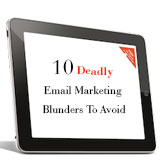Ever since Hotmail launched its first web-based email service in 1996 and email marketing evolved subsequently, it continues to remain an extremely popular, tried and tested form of marketing. If channelized in the right direction, a company’s email marketing campaign can build brand awareness, generate valuable leads, maximize sales and build relationships with customers. On the contrary, succumbing to commonly made email marketing blunders can wreak havoc into your marketing efforts. Here’s a list of 10 deadly email marketing blunders to avoid at all costs:
1. Sending from an unfriendly looking email id: Supposing you receive three mails one from vindxx438@gmail.com, sales@rediff.com and Edward_Jones@seosolutions.com, which one would you prefer to open and read? (The first one of course is deleted without a second thought!) The second one has low chances of being opened as “sales” is a very generic entity and the third one has maximum chances being opened.
2. Dull Subject Line: The Open Rate of your email is primarily dependent on its subject line more than anything else. With millions of marketing emails sent out every day, most of us have developed a default mechanism to select all and delete most of them without even bothering to open. It is only when the subject line invokes some interest in us, that we decide to open the mail and check what it is about. So if your subject line doesn’t stand out from the crowd, people will never be keen to open your emails, let alone read them.
3. Lengthy emails: With looming deadlines, pressing targets and tight schedules, no one really has the time to wade through a long email. It’s simple human tendency- if the end-user cannot scan your email within 30 seconds of opening, the threshold of patience is exceeded, and your email is trashed. This implies that you have the liberty of using a maximum of 4 paragraphs, with 3 to 4 sentences in each of them. Keep your sentences short, crisp and to-the-point.
4. Conveying your message using only graphics: Although graphics are more eye-catching than plain text, most people have graphics switched off on their emails. With more and more users reading emails on their smartphones, people generally don’t have the time to wait for graphics to load. So use graphics in a way that doesn’t hamper the objective and CTA’s of your email.
5. Not proof-reading: Even a single typo, punctuation or grammatical error can cause a major turn-off, and raise doubts about your professionalism and credibility. After thorough proof reading, it is suggested that you test send the mail to yourself to re-check the errors.
6. Sending a “Fit-to-All” Mail: Creating personalized emails based on the target market segment is necessary. The requirements of a loyal customer, a new customer and a potential customer will be very different from each other. Use your database to collect as much information as you can about customers, and personalize emails based on the requirement of each segment.
7. Sounding like a Spammer: Excessive use of capital letters and exclamation marks can activate spam filters and send your mail to the spam folder, destined to be lost forever. Not providing an “unsubscribe” link is another negative point, and is illegal as per the European Distance Selling Regulations.
8. Failing to hit the pedal on time: The timing of your email is also very important in terms of cashing in on festival offers, sale periods and so on. Sending emails either too early or too late will not evoke the expected response from customers.
9. Not revealing Contact Details: More than anything else, this raises issues of trust and credibility. A good email marketer should always be upfront about sharing contact details with clients and offering several options for them to get in touch for further information.
10. Not keeping track of Marketing Email Metrics: As the famous saying goes, “You can only improve what you can measure.” A good Email Marketing Campaign needs to be guided by proper metrics that show you the way ahead. The important ones are Open Rates, Click Through Rates, Bounce Rates, number of unsubscribe and number of email-generated social media links.



Add Comment